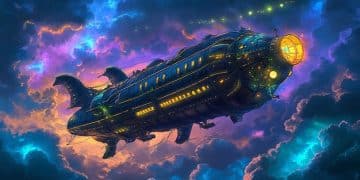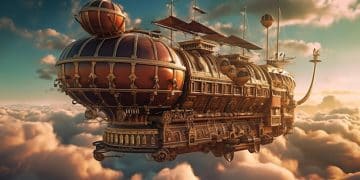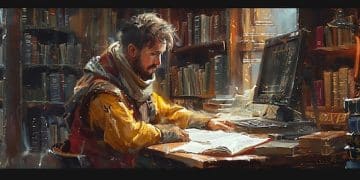LitRPG Evolution: Leveling Up with Gaming Trends in Novels
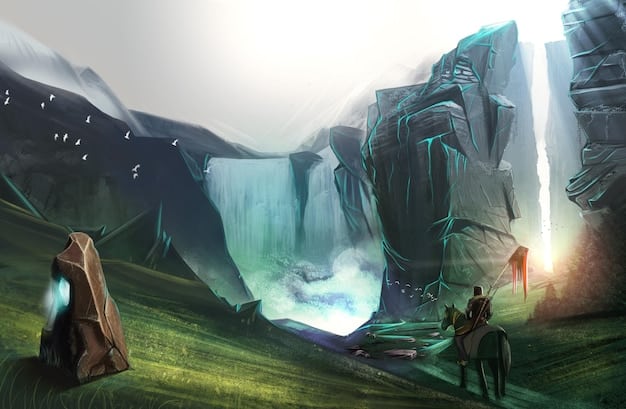
LitRPG novels are evolving by incorporating the latest gaming trends, creating immersive experiences for readers through innovative mechanics, engaging narratives, and deeper connections with virtual worlds.
LitRPG’s Level Up: How LitRPG Novels are Evolving with the Latest Gaming Trends demonstrates the genre’s capacity to reflect and integrate changes in the gaming world, offering new narrative possibilities and enhanced reader engagement.
The Rise of LitRPG and Its Core Mechanics
LitRPG, a genre blending literary storytelling with role-playing game mechanics, has surged in popularity. Understanding its roots and foundational elements is key to appreciating its evolution.
The genre combines the immersive qualities of literature with the engaging, progression-based systems found in video games, offering readers a unique experience.
Origins and Influences
LitRPG emerged from online communities and fan fiction. It started as a niche interest and has grown into a significant literary movement.
Early influences include tabletop RPGs like Dungeons & Dragons, MMORPGs such as World of Warcraft, and Japanese light novels.
- Early web serials on sites like Royal Road helped establish the genre.
- Authors sought to merge the depth of traditional novels with the appeal of gaming progression.
- The genre gained traction as more readers embraced the fusion of literature and gaming.
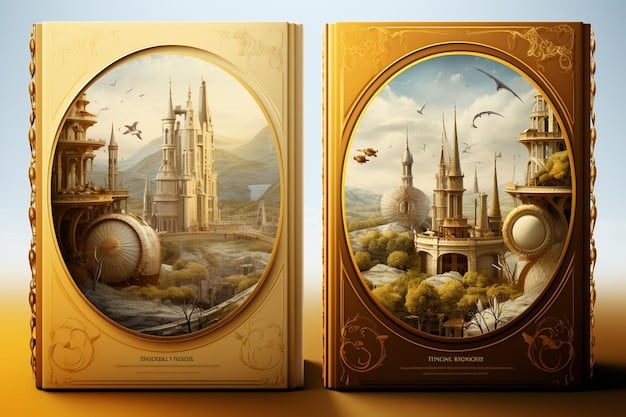
Core Mechanics of LitRPG
At the heart of LitRPG are several key elements that define the genre and differentiate it from traditional fantasy.
These mechanics provide structure and engagement, mirroring the experience of playing a game.
- Stats and Character Sheets: Numerical attributes that define a character’s abilities.
- Leveling Systems: Progression mechanics where characters gain experience and improve their skills.
- Skills and Abilities: Special powers and techniques that characters can learn and use in combat or other situations.
- Loot and Equipment: Items that characters acquire to enhance their capabilities.
The blend of storytelling and game mechanics creates a unique reading experience, appealing to both gamers and book lovers.
Incorporating Modern Gaming Trends
Modern gaming trends significantly impact the evolution of LitRPG. By integrating these trends, authors enhance the immersion and appeal of their stories.
These contemporary elements resonate with readers who are familiar with the latest developments in the gaming world.
Virtual Reality (VR) and Augmented Reality (AR)
VR and AR technologies offer new narrative possibilities for LitRPG authors, allowing for more immersive and believable virtual worlds.
These technologies enable readers to imagine more vividly the environments and experiences described in the books.
- Stories often feature characters who are fully immersed in virtual worlds through VR headsets or similar devices.
- AR elements can blend the real world with game-like interfaces, creating a sense of augmented reality within the narrative.
- The integration of VR and AR can lead to innovative plot devices and character interactions.
Esports and Competitive Gaming
The rise of esports and competitive gaming provides a rich source of inspiration for LitRPG authors. These elements add excitement and strategic depth to stories.
The inclusion of competitive gaming scenarios allows for thrilling action and complex character development.
- Stories may focus on characters who are professional gamers competing in tournaments within virtual worlds.
- Strategic elements from games like League of Legends or Dota 2 can be adapted into LitRPG narratives.
- The pressure and intensity of esports can drive character arcs and create dramatic tension.
The integration of modern gaming trends keeps LitRPG fresh and relevant, attracting a wider audience.
Narrative Innovations in LitRPG
Narrative techniques in LitRPG are evolving to provide richer, more engaging stories. Authors are experimenting with new approaches to storytelling.
These innovations enhance reader immersion and create more compelling narratives.
Deeper Character Development
Modern LitRPG emphasizes more profound character development. Characters evolve not only in terms of stats but also emotionally and psychologically.
This focus creates a stronger connection between readers and the protagonists.
- Characters face moral dilemmas and emotional challenges that influence their growth within the game world.
- Backstories and personal motivations are explored in detail, adding depth to their actions and decisions.
- Relationships between characters are more complex and nuanced, creating meaningful interactions.
Complex Plot Structures
Emerging LitRPG stories often feature more intricate and multi-layered plot structures.
These structures add depth and complexity to the narrative, keeping readers engaged and surprised.
- Multiple storylines intertwine, creating a richer and more immersive world.
- Mystery and intrigue are incorporated to drive the plot forward and keep readers guessing.
- Unexpected twists and turns challenge characters and readers alike.

Narrative innovations help LitRPG evolve beyond simple power fantasies, offering more meaningful and thought-provoking stories.
The Influence of Game Design on LitRPG Structure
Game design principles are increasingly influencing the structure and pacing of LitRPG novels. This integration enhances the engagement and satisfaction of readers, mirroring the rewarding experiences found in video games.
Applying game design elements to storytelling creates a unique and compelling reading experience.
Quest-Based Storytelling
Adopting quest-based storytelling allows authors to structure their novels around clear objectives and progression milestones.
This approach provides readers with a sense of accomplishment as characters complete tasks and advance the plot.
- Main quests drive the overarching narrative, providing a central goal for the characters to achieve.
- Side quests offer opportunities for character development, world-building, and additional rewards.
- Quest logs and progress trackers can be integrated into the narrative, creating a game-like experience.
Worldbuilding and Lore
Detailed worldbuilding and expansive lore enhance the immersion and believability of LitRPG settings. A well-developed world can captivate readers and provide a rich backdrop for the story.
Focusing on the creation of intricate and detailed worlds creates a deeper and more immersive setting for the story to unfold.
- In-depth descriptions of environments, cultures, and histories bring the virtual world to life.
- Unique creatures, factions, and magical systems add depth and complexity to the setting.
- Lore is revealed gradually, enticing readers to explore the world and uncover its secrets.
By aligning with game design principles, these stories deliver a rewarding experience for readers.
Interactivity and Reader Engagement
Interactivity and reader engagement are crucial elements in the evolution. Authors explore new ways to involve readers in the story.
By fostering a connection, authors can create a loyal and enthusiastic audience.
Interactive Fiction Elements
Incorporating interactive fiction elements allows readers to influence the story’s outcome.
This approach creates immersive and engaging reading experience.
- Choose-your-own-adventure mechanics can be implemented to allow readers to make decisions that affect the plot.
- Polls and surveys can be used to gather feedback and shape the direction of the story.
- Interactive maps and character sheets can enhance the reading experience.
Community Building
Building a strong community around books fosters engagement and creates a sense of belonging.
Engaging with the readers can help fuel the growth and popularity of the genre.
- Online forums and social media groups provide platforms for readers to discuss and share their thoughts.
- Live streams and Q&A sessions can connect authors with their audience in real-time.
- Fan art and fan fiction can be encouraged to celebrate the community.
Interactivity and reader engagement transform the reading experience, making it more dynamic and collaborative.
Future Trends in LitRPG
The future holds exciting possibilities for. Emerging technologies and storytelling techniques will continue to shape the genre.
Keeping up with current trends is essential for authors and readers alike.
AI and Procedural Generation
AI and procedural generation could revolutionize worldbuilding and quest design.
These technologies can create dynamic and evolving stories.
- AI can generate unique quests and storylines based on reader preferences.
- Procedural generation can create vast and detailed virtual worlds with minimal human input.
- AI-driven characters can react and evolve in response to reader interactions.
Cross-Media Integration
Integrating with other media formats, such as video games, anime, and graphic novels, can expand the reach and influence of the genre.
This integration offers new ways for readers to experience and interact with the stories.
- LitRPG novels can be adapted into video games, allowing readers to play through the stories they love.
- Anime and manga adaptations can bring the characters and worlds to life in new ways.
- Cross-promotional partnerships can introduce to new audiences.
The future holds endless potential for the evolution, driven by technology and creative innovation.
| Key Aspect | Brief Description |
|---|---|
| 🎮 Gaming Elements | Incorporating game mechanics like stats and leveling creates immersive experiences. |
| ✨ Narrative Depth | Evolving character development and plot structures provide richer stories. |
| 🌐 Modern Trends | Integrating VR, AR, and esports keeps LitRPG fresh and relevant. |
| 🗣️ Reader Engagement | Interactivity and community building enhance the reader experience. |
Frequently Asked Questions
▼
Core elements include stats, leveling systems, skills, and loot. These mechanics mimic role-playing games, creating a unique reader experience. Character sheets and progression are integral to the plot and character development.
▼
Modern gaming trends like VR, AR, and esports have profoundly influenced LitRPG. They offer authors innovative narrative possibilities, immersive world-building, and exciting character interactions, enhancing the genre’s appeal.
▼
Narrative innovations include deeper character development and complex plot structures. Stories now emphasize emotional and psychological growth, creating compelling relationships and intricate interwoven storylines, enhancing reader engagement.
▼
Game design principles like quest-based storytelling and detailed worldbuilding are increasingly used. This structures novels around clear objectives, providing readers with a sense of accomplishment and a richer, more immersive experience.
▼
Future trends include AI-driven content generation and cross-media integration. AI can create unique quests, while cross-media adaptations like video games and anime offer new ways for readers to interact with stories.
Conclusion
LitRPG is more than just a fusion of literature and gaming; it’s a constantly evolving genre that adapts and innovates with the times. By embracing modern gaming trends, pushing narrative boundaries, and fostering community engagement, LitRPG continues to level up, offering readers captivating and immersive experiences that blur the lines between reality and virtuality.
